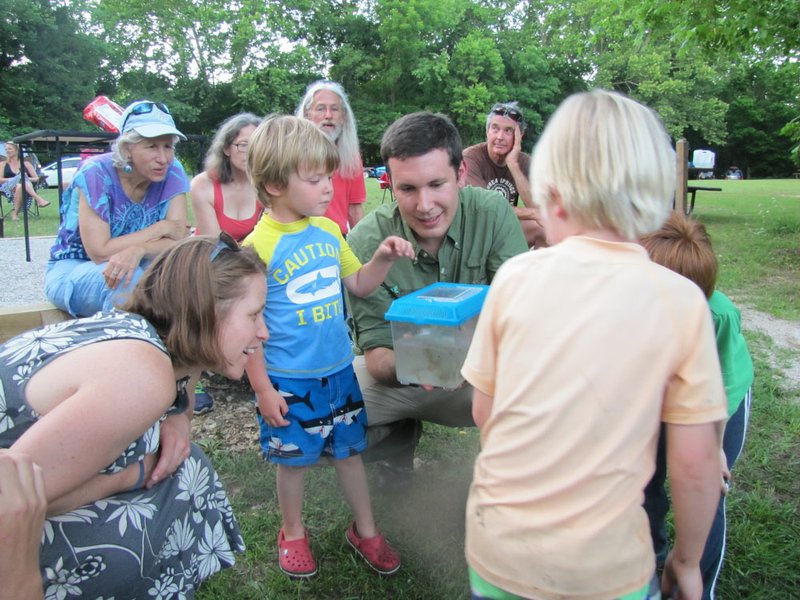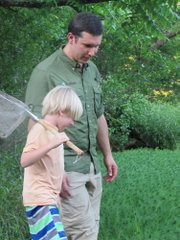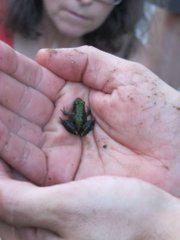The frogs had been calling all evening, but at about 8:30 p.m. Sunday, about sundown, the chorus came on full th
roat.
The green frog, with an occasional call sounding like the plunking of a banjo string. The green tree frog with a goose-like honk. The gray tree frog with a rattle sounding like a New Year's toy. The dwarf American toad with a long trill like the sound of someone running a finger across a plastic comb. The Southern leopard frog sounding like a thumb rubbing over an inflated balloon. The Eastern narrow-mouth toad sounding like a sheep's "baa." The Blanchard's cricket frog provided percussion that sounded like two steel balls being hit together. And the American bullfrog added his deep bass, "Rum. Rum."
Hear the calls of 23 species of frogs that make their homes in habitats throughout the Natural State
Volunteer training
Who: New FrogWatch volunteers
When: Noon to 4 p.m. July 16
Where: Hobbs State Park
Information: 789-5000, 966-4666
"I knew they'd really start calling when everybody left," said Lilia Beattie, FrogWatch chapter director and Arkansas Master Naturalist. The groups held a picnic and "listening party" Sunday evening on the banks of Lake Leatherwood Park in Eureka Springs. Many people had left hoping to beat the dark out of the park in the Ozark Mountains.
"I don't think it's by accident. Those frogs know what they are doing," Beattie added.
She explained the male frogs were calling for mates, and females seem more receptive to mating in the safety of the dark.
"It seems like you're faking it, but if you cup your hands to your ears, you can hear so much better," said Sim Barrow, communications and development coordinator for the Northwest Arkansas Land Trust, offered advice to those who wanted to hear the frogs.
Twenty-three species make their home in various habitats across Arkansas. Eight made themselves known in the Eureka Springs lake.
FrogWatch USA, with local chapters across the country, uses volunteers to record the species of frogs and approximate populations based on the calls heard at various locations from February to August. Beattie chooses to do her listening at Lake Leatherwood.
"This is my monitoring site, and I like to share it with everyone," she said.
"But a lot of people are afraid they will have to drive to the woods to hear the frogs and participate," said Tim Edmiston, a Master Naturalist. "But frogs stay near water. So you can do it anywhere close by. You can do it at your house."
"A lot of people want answers to questions about herpetology," said Barrow, who was on hand to answer some of those. "Like, what sort of environmental factors motivate a frog to begin calling? Is it a large rain?"
Barrow explained the FrogWatch monitoring protocol asks its volunteers to record things like weather conditions and temperature for each monitoring session. "Then they share the science with us."
FrogWatch's citizen science program doesn't require formal training, and the volunteers can provide useful information about frog populations. In fact, this program has revealed some information about green tree frogs, Barrow said.
Beattie recorded the calls of green tree frogs at Lake Leatherwood, which lay beyond that frog's geographic range, according to most scientific maps. "The maps don't say the green frogs are in Northwest Arkansas," Barrow explained. "So the maps are wrong. So either [the green tree frogs] have moved, or they've always been here and we didn't know it.
"One of the important things FrogWatch data can tell is a range shift in a frog population," Barrow continued. "One species moving into another area could mean a new competition in a habitat or changes in the environment, such as a warming climate. The reasons could have real ecological impacts.
"But at this point, it's just a really interesting thing to document. I doesn't necessarily mean those things are in play," he said. Only extensive research could reveal the reason for the change.
One purpose of Sunday's event was to inspire others to volunteer for FrogWatch. "We want as many people as possible to take the class," Barrow said. A three-hour workshop introduces participants to the calls of the 23 species of frogs in Arkansas and details habitat.
Fred Hopkins of Eureka Springs brought his grandchildren to the event. "I hear a lot of frogs at home, but I don't know one from the other. I hear that one all the time," he said at one call. "I've learned to identify a cricket frog and a green tree frog."
"I really want to know all the names and all the sounds," said Katie Wood of rural Carroll County. "My kids are interested. We like to do lots of outdoors stuff."
Beattie and Barrow exhibited great patience as adult participants asked one after another, "What frog was that?"
Then Barrow gathered children to catch frogs or tadpoles to show the group.
"Tadpoles turn into frogs," announced Katie's son, Dakota Wood, 5.
"The [frogs] might hide if we make a lot of noise. Sit here close to the water, and stand very still," Barrow told the children in vain. "If we sit quietly and wait for the frogs, they might forget we're here."
The frog-hunting expedition turned into playing in the mud puddle as child after child (and one reporter) got his shoes stuck in the mud on the bottom of the lake and fell into the water.
"We didn't catch a single frog, but we got dirty butts," reported 8-year-old Violet Milwagon of Eureka Springs. "We found a lot of of mud."
"Noah really wants to catch a frog," Katie Wood said of her other son. "But he had a tadpole in a cup earlier, so he's OK."
Barrow prevailed, however, and was able to capture one tiny cricket frog, greeted with "Oohs" and "Aaahs" of appreciation from the adults. This frog bore a rich, jewel-tone green skin, but sometimes they are slate gray with black spots, Barrow explained.
"This is as big as they get," he said of the frog in his hand that would measure maybe "1 inch, soaking wet."
"They like to live in the lake and in the forest," Barrow continued. "If you see a frog jump away from you on a trail, it's probably a Blanchard."'
NAN Our Town on 06/15/2017



